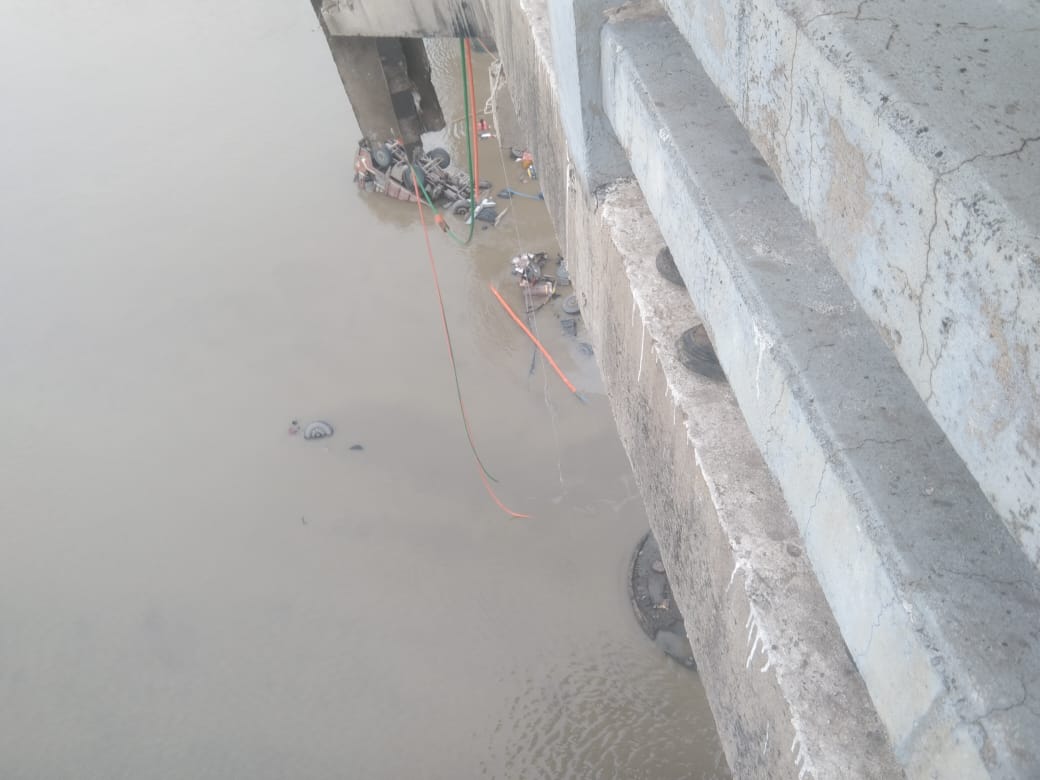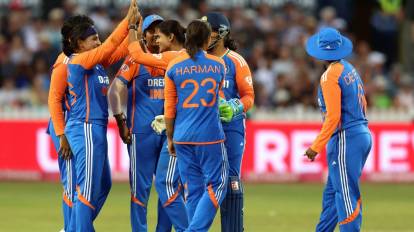1. The Morning Shock — What Happened on July 9, 2025:Gambhira Bridge
In the early hours of Wednesday, July 9, 2025, the Gambhira Bridge a vital concrete link on the Padra–Mujpur route spanning the Mahi (Mahisagar) River—collapsed without warning, sending multiple vehicles hurtling into the river below. According to official updates, fatalities rose to at least 12 (and in some reports, up to 13) with several others injured and many more feared missing
Eyewitnesses described chilling scenes: at approximately 7:30 a.m., a loud cracking noise rang out. Moments later, a slab bridging two piers gave way. On the bridge at the time were multiple vehicles—including two trucks, two vans, and an autorickshaw (and possibly more)—that plummeted into the tumultuous waters. Some survivors narrowly escaped, leaping onto precarious remnants; others were trapped inside submerged vehicles.
One of the most harrowing images from the scene captured a fuel tanker hanging on the brink of collapse, its driver believed to have escaped in the confusion . Local residents assisted frantic rescue efforts, rowing boats into swirling currents to retrieve survivors and recover bodies.
2. The Human Toll — Lives Lost & Lives Saved
Adequate final death and injury counts varied across sources: initial reports stated nine dead, later rising to 10, then 11, 12, and even 13 Injuries numbered between five and nine.
Among the victims were whole families. According to The Indian Express, three members of the Padhiyar family died Tragically, a two‑year‑old boy and his four‑year‑old sister were also confirmed among the deceased.
Amid heartbreak, there were miraculous rescues: eyewitnesses recounted how motorists braked at the last moment and leapt onto retreating roadbeds . Villagers and emergency services pulled at least nine to ten people alive from the water. One mother’s anguished cries, captured in a video and widely shared, echoed through the tragedy:
“Maaro chokra doobi gayo” (“My child is drowning!”)
3. Profiles of Gambhira Bridge: Age, Design, History
Constructed in 1985–and opened to the public the same year–the Gambhira Bridge was a 859‑metre, concrete road bridge built to last 100 years. It connected Padra in Vadodara district with Gambhira in Anand district, carrying essential traffic between Central Gujarat and Saurashtra.
However, locals had long decried its unsafe condition. The bridge had gained a reputation as a “suicide point” and was repeatedly flagged for structural weaknesses—even as it was periodically repaired. Warnings from the community and even political parties calling for its closure to heavy vehicles were reportedly ignored.
4. Rescue Operations: Swift, Large‑Scale, Heart‑Rending
The collapse triggered an immediate and extensive rescue mission. State Disaster Response Force (SDRF), National Disaster Response Force (NDRF), local fire brigades, police, and villagers converged on the site. Dr. N. M. Nayakawala, Executive Engineer of Vadodara R&B Dept, confirmed medical teams were on site treating the injured
Rescue divers, cranes, and JCB machines were used to draw submerged vehicles from the river India Today. CG Rohan Anand and other officials coordinated between Padra and Vadodara offices—evacuating and treating victims in local hospitals like Padra Referral and Vadodara SSG Hospital.
Yet the rescue was fraught with anguish: bodies were found after hours of relentless search over currents still carrying debris and vehicles. A second morning saw two more bodies recovered—bringing the confirmed death toll beyond twelve .
5. Probing the Collapse—“Cracks Before Our Eyes”
Eyewitnesses painted a scene of sudden betrayal by steel and concrete. Sanjaybhai Somabhai Chavda, a 25‑year‑old biker, said the collapse felt like an earthquake:
“It felt like an earthquake was happening,” he described, recalling how he abruptly braked and jumped to safety.
Others saw the slab give way, swallowing cars and bikes; one witness escaped by climbing atop a vehicle in the water, aided by locals with boats .
Villagers who rushed to help spoke of rescuing a stranded woman and several drivers from the river . The heroism of these local efforts will remain a small beacon in the shadows of tragedy.
6. Official Response: Condolences, Compensation, Inquiry
Leading voices expressed sorrow and offered support:
President Droupadi Murmu conveyed deep condolences and voiced hopes for the injured’s recovery.
Prime Minister Narendra Modi described the event as deeply saddening, announced ₹2 lakh ex‑gratia from PMNRF to families of the deceased, and ₹50,000 to the injured .
Gujarat CM Bhupendra Patel extended state support—announcing ₹4 lakh from the state fund for each deceased’s family and ₹50,000 for injured individuals. He also ordered detailed investigations, convened a cabinet-level meeting, and summoned R&B officials for explanations.
A technical probe team—including state engineers and private experts—was dispatched to the site to determine the structural failures . CM Patel, joined by Health Minister Rushikesh Patel, emphasized equitable treatment and infrastructural accountability.
7. Infrastructure Safety: Gujarat’s Troubled History
This disaster reignites debate over infrastructure integrity. Despite reforms following past bridge/flyover collapses, Gujarat’s infrastructure remains vulnerable—particularly during monsoons.
Post-2014, after a disastrous flyover plunge in Surat, the state introduced stricter materials standards—such as M‑40 concrete, FE‑550D steel—and mandatory monsoon inspections . Yet incidents kept recurring: in 2017, a flyover slab collapse in Ahmedabad, and again during the Gambhira bridge failure.
Officials called for rigorous enforcement of updated norms—temporary supports for girders, certified operators, modular joints—but practical supervision appears weak.
8. Political Fallout & Civic Criticism
Political and local backlash centered on alleged government apathy and financial mismanagement:
Opposition Congress highlighted the tragedy as symptomatic of governance failures, sharing video footage to underscore “infrastructure decay” LatestLY.
Local residents protested that repeated repair appeals over years went unanswered India TV News.
Public anger mounts over ignored warnings and warnings about structural weakness—echoed in earlier media calls for heavy vehicle restrictions .
The CM’s political gamble lies in whether inquiry results will translate into accountability, safety reinforcements, and stricter oversight—or again be lost in bureaucratic inertia.
9. At What Cost? — Digesting the Sobering Financial Impact
In a span of a day, responses materialized in dollars and rupees, but the societal cost is far graver:
Ex-gratia payouts: PMNRF ₹2 lakh + state ₹4 lakh = ₹6 lakh per deceased; ₹1 lakh total support per injured.
Bridge replacement: A new ₹212 crore bridge had already been sanctioned three months ago—but only now does its urgency crystallize in tragic reality.
Economic disruption: Transport flow between Anand and Saurashtra is stalled, forcing detours and stretching supply chains.
Psychological trauma: Families of victims, survivors, and rescue personnel bear scars far deeper than temporary funds.
10. Lessons and the Road Ahead
A. Enforcement Over Guidelines
Gujarat’s bridge issue isn’t one of rules—it’s of enforcement. Mandated materials, monthly inspections, and monsoon-duty should be paired with strong third-party audits and real-time data monitoring.
B. Early Warnings Must Hold Weight
Local reports of deterioration and overflow at Gambhira were brushed aside. Whistleblowers need safe channels—and swift action. Local government, engineers, and residents need integration.
C. No Delay on Replacement Projects
Approval for a ₹212 crore replacement bridge became meaningful only after tragedy struck. If preemptive projects are delayed, they morph into reactive band‑aids, not investments in safety.
D. Community Involvement Saves Lives
Villagers leaped into the Mahisagar without waiting for orders—and their courage saved lives. Integrating citizen volunteers into disaster training could enhance future response.
11. Human Stories: Glimmers Amid Grief
Among chaos, moments of compassion stood out:
Youths escaping by brakes-alone, leaping off the disintegrating deck.
Villagers launching impromptu rescue boats .
Mothers and children, traumatized yet surviving the sinking vehicles .
Their courage and presence of mind softened the blow of this catastrophe.
12. What This Means for Infrastructure Safety in India
The Gambhira Bridge collapse is not just a local tragedy—it is a cautionary national tale:
India’s ageing roads and bridges—many built in the ’60s–’80s—are approaching expiry.
Climate volatility and annual monsoons add stress to structures never envisaged for 21st‑century traffic.
Periodic tragedies—from Morbi (2022) to Surat (2014) to Gambhira (2025)—highlight systemic decay.
National infrastructure programs must prioritize maintenance and thick inspection logs over glossy inaugurations.
13. For Stakeholders: What Must Be Done
| Stakeholder | Action |
|---|---|
| Government | Enforce monsoon inspections, mandate periodic audits by independent agencies, allocate maintenance budgets separate from new builds |
| Engineers / R&B Dept | Maintain real-time structural health monitoring (sensors, drones), implement rapid-response teams, ensure certified operators |
| Politicians / Elected reps | Bring constituent concerns to legislative notice; approve funding for vulnerable structures proactively |
| Civil Society | Demand transparency in audits; participate in citizen-led bridge/mapping trusts; monitor engineering reports |
| Media / Watchdogs | Continue investigative reporting on neglected structures; highlight successful restoration efforts |
14. The Path to Healing: Memorials & Support
In the wreckage’s aftermath, Gujarat’s government and aid agencies are:
Supporting counseling for affected families and survivors.
Establishing local memorial services to honor those lost.
Honoring rescue contributors—villagers, NDRF divers, local responders—for their bravery.
These initiatives are essential to restore trust and communal resilience.
15. Looking Ahead: Pragmatism Before Politics
As the investigation unfolds—with a team expected to report within days—public scrutiny remains high. If findings reveal systemic failures or negligence, prosecutions and engineering overhauls must follow, not obscurations.
Meanwhile:
Traffic continues along diversions via Sindhrot and Vasad .
Construction has begun on the new ₹212 crore bridge .
Infrastructure safety protocols are being urgently reviewed.
Final Thoughts:Gambhira Bridge
The collapse of the Gambhira Bridge is not merely another tragic headline—it is a reckoning. At least 12 lives have been lost; countless more altered forever. Yet amid the grief, there remains an opportunity for change.
If this moment propels India to treat neglected infrastructure as a public health emergency—mobilizing engineering audits, strengthening enforcement laws, empowering citizens, and valuing community heroes—the Gambhira Bridge’s collapse won’t have been in vain.
But the road from tragedy to transformation demands accountability, transparency, and reconnection between communities and institutions. Only then can we honor the memories of those lost by rebuilding not just bridges, but bridges of trust—and safety—that will carry us forward. more news click here.







